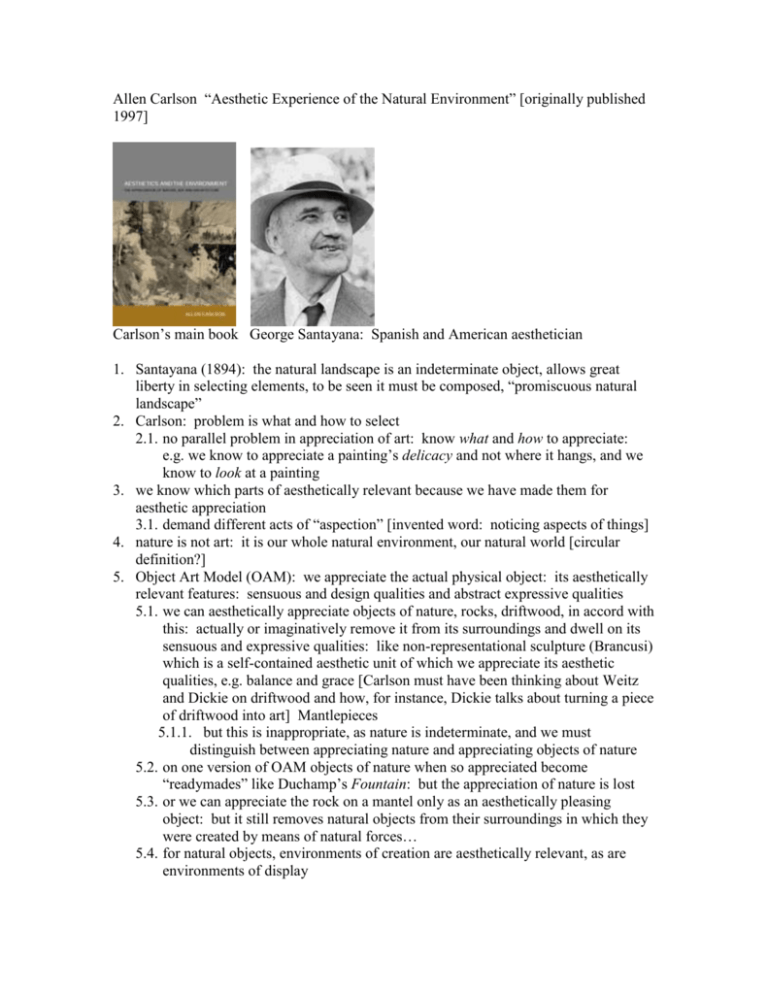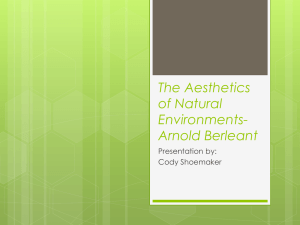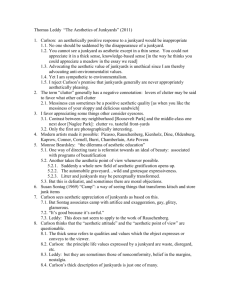Allen Carlson “Aesthetic Experience of the Natural Environment
advertisement

Allen Carlson “Aesthetic Experience of the Natural Environment” [originally published 1997] Carlson’s main book George Santayana: Spanish and American aesthetician 1. Santayana (1894): the natural landscape is an indeterminate object, allows great liberty in selecting elements, to be seen it must be composed, “promiscuous natural landscape” 2. Carlson: problem is what and how to select 2.1. no parallel problem in appreciation of art: know what and how to appreciate: e.g. we know to appreciate a painting’s delicacy and not where it hangs, and we know to look at a painting 3. we know which parts of aesthetically relevant because we have made them for aesthetic appreciation 3.1. demand different acts of “aspection” [invented word: noticing aspects of things] 4. nature is not art: it is our whole natural environment, our natural world [circular definition?] 5. Object Art Model (OAM): we appreciate the actual physical object: its aesthetically relevant features: sensuous and design qualities and abstract expressive qualities 5.1. we can aesthetically appreciate objects of nature, rocks, driftwood, in accord with this: actually or imaginatively remove it from its surroundings and dwell on its sensuous and expressive qualities: like non-representational sculpture (Brancusi) which is a self-contained aesthetic unit of which we appreciate its aesthetic qualities, e.g. balance and grace [Carlson must have been thinking about Weitz and Dickie on driftwood and how, for instance, Dickie talks about turning a piece of driftwood into art] Mantlepieces 5.1.1. but this is inappropriate, as nature is indeterminate, and we must distinguish between appreciating nature and appreciating objects of nature 5.2. on one version of OAM objects of nature when so appreciated become “readymades” like Duchamp’s Fountain: but the appreciation of nature is lost 5.3. or we can appreciate the rock on a mantel only as an aesthetically pleasing object: but it still removes natural objects from their surroundings in which they were created by means of natural forces… 5.4. for natural objects, environments of creation are aesthetically relevant, as are environments of display 6. Landscape or Scenery Model (LSM): appreciation of natural environment as if it were a series of landscape paintings: prospects, scenes, appropriate distance: visual qualities relating to lone, color, overall design: picturesque as picture-like: “scenic viewpoints” with soft or “highest” coloring and “just perspective” 6.1. reduces a walk in the natural environment to something like a stroll through a gallery 6.2. moral problems: Rees: confirms our anthropocentrism [human-centered attitude] and allows our abuse of local environments 6.3. aesthetic problems: natural environment is not a scene, not static, not 2-D: Hepburn: people will look in vain for what can be enjoyed only in art 7. alternative: deny aesthetic appreciation in nature since aesthetic appreciation requires aesthetic evaluation, judging an object as an achievement: one version is Human Chauvinistic Aesthetic (HCA) Elliot: nature is not a work of art 7.1. but the orthodox view is that everything is open to aesthetic appreciation and there are some instances of aesthetic appreciation of natural things: fiery sunsets 8. another alternative: [AOE: Aesthetics of Engagement: associated with Arnold Berleant] replace abstraction with engagement, distance with immersion 8.1. but some subject/object dichotomy is necessary for aesthetic appreciation 8.2. AOE is too subjective 9. neither HCA nor AOE answer the what or the when questions adequately 10. Natural Environmental Model (NEM) [Carlson’s position]: natural and environmental science is the key to aesthetic appreciation of the natural environment 10.1. rejects OAM and LSM 10.2. does not reject traditional structure of aesthetic appreciation of art as a model for aesthetic appreciation of the natural world 10.3. with Santayana: natural environment is indeterminate and promiscuous etc., and the vague stimulus must be composed to be appreciated 10.4. the composition must be in terms of common sense and scientific knowledge 10.5. encourages appreciation of nature for what it is: this helps dispel environmental and moral criticisms: not anthropocentric 10.6. aligns with other areas of philosophy depending on [scientific] knowledge of the phenomena in question Question for Carlson: how can you both compose nature to aesthetically appreciate it and also appropriately appreciate it for what it truly is? How ought one to appreciate the natural environment? Are there any flaws in Carlson’s own model? Has Carlson over-criticized the older models?




